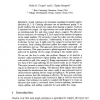Free Online Productivity Tools
i2Speak
i2Symbol
i2OCR
iTex2Img
iWeb2Print
iWeb2Shot
i2Type
iPdf2Split
iPdf2Merge
i2Bopomofo
i2Arabic
i2Style
i2Image
i2PDF
iLatex2Rtf
Sci2ools
CC
1998
Springer
1998
Springer
Live Range Splitting in a Graph Coloring Register Allocator
Graph coloring is the dominant paradigm for global register allocation [8, 7, 4]. Coloring allocators use an interference graph, Z, to model conflicts that prevent two values from sharing a register. Nodes in 2: represent live ranges. An edge between two nodes indicates that they are simultaneously live azld, thus, cannot share a register. The allocator tries to construct a k-coloring of 2:, for k equal to the number of registers on the target machine. If it succeeds, it maps the colors onto the machine registers to produce an allocation. Unfortunately, it may not discover a k-coloring. In that case, it sp///s some live ranges by saving their values to memory. Early coloring allocators spilled live ranges completely - at each definition and use. This approach often introduces more spill code than necessary. This paper presents a global approach that avoids some spill code by splitting the live range, breaking it into smaller pieces. We are not the first to study this problem. Bergner e...
Related Content
| Added | 21 Dec 2010 |
| Updated | 21 Dec 2010 |
| Type | Journal |
| Year | 1998 |
| Where | CC |
| Authors | Keith D. Cooper, L. Taylor Simpson |
Comments (0)

